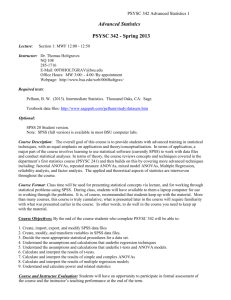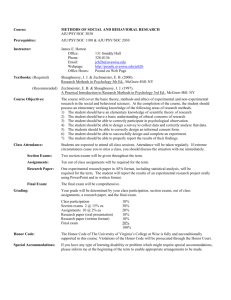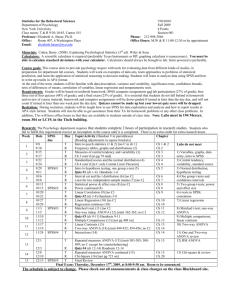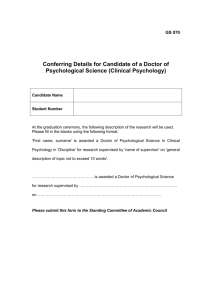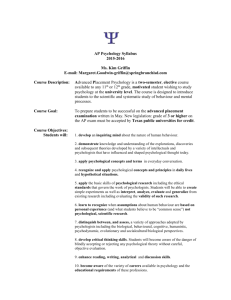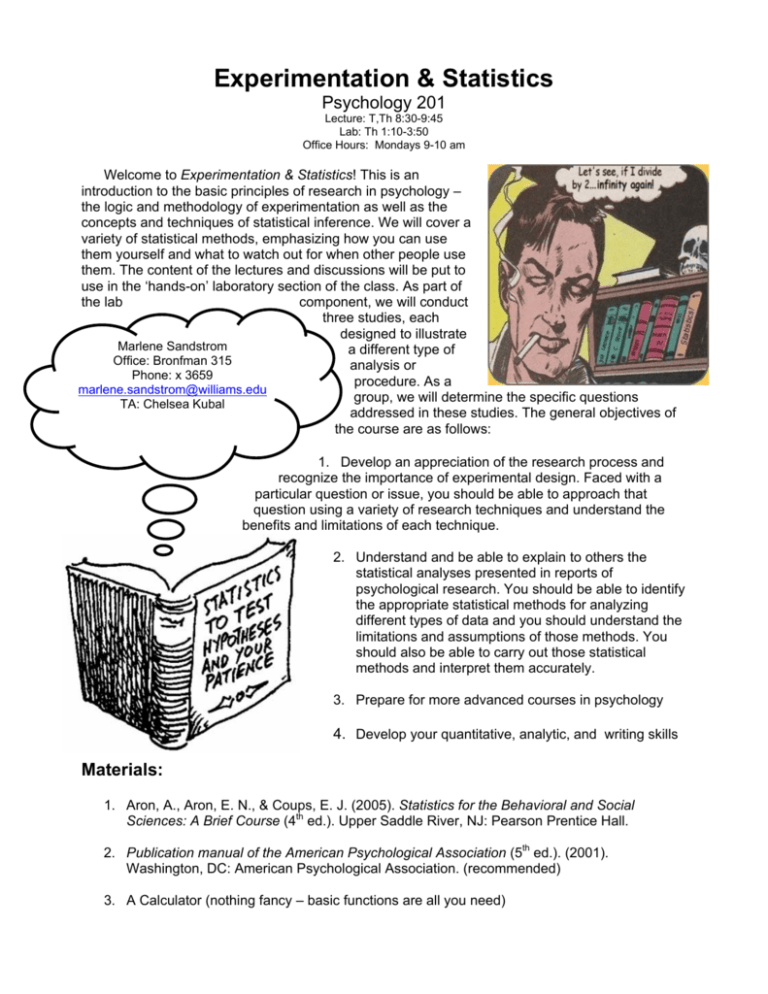
Experimentation & Statistics
Psychology 201
Lecture: T,Th 8:30-9:45
Lab: Th 1:10-3:50
Office Hours: Mondays 9-10 am
Welcome to Experimentation & Statistics! This is an
introduction to the basic principles of research in psychology –
the logic and methodology of experimentation as well as the
concepts and techniques of statistical inference. We will cover a
variety of statistical methods, emphasizing how you can use
them yourself and what to watch out for when other people use
them. The content of the lectures and discussions will be put to
use in the ‘hands-on’ laboratory section of the class. As part of
the lab
component, we will conduct
three studies, each
designed to illustrate
Marlene Sandstrom
a different type of
Office: Bronfman 315
analysis or
Phone: x 3659
procedure. As a
marlene.sandstrom@williams.edu
group, we will determine the specific questions
TA: Chelsea Kubal
addressed in these studies. The general objectives of
the course are as follows:
1. Develop an appreciation of the research process and
recognize the importance of experimental design. Faced with a
particular question or issue, you should be able to approach that
question using a variety of research techniques and understand the
benefits and limitations of each technique.
2. Understand and be able to explain to others the
statistical analyses presented in reports of
psychological research. You should be able to identify
the appropriate statistical methods for analyzing
different types of data and you should understand the
limitations and assumptions of those methods. You
should also be able to carry out those statistical
methods and interpret them accurately.
3. Prepare for more advanced courses in psychology
4. Develop your quantitative, analytic, and writing skills
Materials:
1. Aron, A., Aron, E. N., & Coups, E. J. (2005). Statistics for the Behavioral and Social
Sciences: A Brief Course (4th ed.). Upper Saddle River, NJ: Pearson Prentice Hall.
2. Publication manual of the American Psychological Association (5th ed.). (2001).
Washington, DC: American Psychological Association. (recommended)
3. A Calculator (nothing fancy – basic functions are all you need)
Requirements:
Attendance
No way around it. The simple truth is that you must
come to every lecture and lab. This course IS NOT
composed of separate modules; you cannot skip sections
and hope to understand later material. Instead, each class
takes previous material and builds on it.
Preparing for class: You will get much more out of the
lectures if you read the assigned material before class. I
recommend you read the assignment before class, noting
those sections of the reading that you find difficult. After lecture, review your readings a second
time. If you do, your understanding of the material will be significantly more complete and lasting!
Assignments
You will periodically be assigned practice problems to solidify your understanding of the
material. These assignments will be due at the beginning of the following class unless otherwise
indicated. These assignments will help reinforce what you have learned. Your performance on the
problem sets can also alert you to difficulties about which you may not be aware. Some problem
sets can be completed by hand and others will require computer work. You must always show your
work. Problem sets should be completed independently. They will be graded on a 10-pt scale and
the lowest grade at the end of the semester will be dropped. LATE PROBLEM SETS WILL NOT
BE ACCEPTED.
One assignment will be a group presentation on the last day of lab. For this 10-15 min
presentation, you will choose one article and give a detailed description of it including the
background, methods, results, and implications. The article will be one that you feel is particularly
relevant to the third study. Each participant in your group will receive the same grade on this
presentation and this presentation will count as one of the regular assignments (though this grade
will not be dropped).
Laboratory Projects
In addition to lectures, all students must attend weekly laboratory meetings (Thursdays from
1:10 - 3:50). Lab sessions will focus on issues of experimental design, methodology, use of
computers in statistical analysis, and presentation of results. A central component of the lab
involves the hands-on experience of designing, conducting, analyzing, and reporting three
separate experimental studies. We will
begin each study by discussing an
empirical issue that we, as a class,
would like to investigate. We will then
design a study to address the research
question and gather the necessary
materials. You will gather the data and
bring it back to the class where we will
compile it into a master data set. You
will then analyze the data independently
using statistical software and write a
2
report of your findings using the preferred format of the American Psychological Association (APA).
By the end of the semester, you will be equipped to develop your own research questions and to
design studies that effectively address those questions. Furthermore, you will be armed with a
number of different analyses, appropriate for different situations. You will also be familiar with the
language and writing style of reports in the field of psychology. The grade for each project will be
based not only on the final written report, but also on your contribution to the design, development
of materials, gathering data, etc. Five percent per day will be deducted for papers submitted late.
Exams
Two midterm exams will be administered in addition to a final at the end of the semester. The
format of the exams will be a combination of multiple choice, short answer and problems involving
calculations. While the second exam will emphasize material covered since the first exam, it is
important to note that the later material builds upon concepts learned during the first part of the
semester. The final exam will be cumulative and will focus on data analysis with SPSS and the
interpretation of findings. You may not reschedule exams and there will be NO make up exams.
Seeking Help
Please feel free to contact me if you are feeling confused about the material. Keep in mind that
the material in this course builds on itself. You owe it to yourself to make sure you really
understand what you are learning each week.
The Honor Code
As you might expect, the Williams College Honor Code applies to this class. You are therefore
expected to work independently and without assistance on the problem sets and exams. You may,
of course, seek assistance from me or the TA. We will all collaborate on designing and
implementing the three studies but the reports are to be written independently. Please note that the
Honor Code also applies to research ethics, including the requirement that all data presented as
genuine must indeed by real (i.e., obtained from testing actual research participants and not faked,
altered, or “cooked” in any way). If you have questions about the Honor Code, plagiarism, author
notes, or related matters, please ask.
Grading
Assignments
Lab Report #1
Lab Report #2
Lab Report #3
Exam #1
Exam #2
Final Exam
15%
10%
15%
15%
15%
15%
15%
3
Schedule and Reading Assignments
M
September
T W T F
4
5
M
October
T W T
F
M
November
T W T F
1
2
3
3
4
5
6
7
8
9
10
11
12
6
7
8
9
10
10
11
12
13
14
15
16
17
18
19
13
14
15
16
17
17
18
19
20
21
22
23
24
25
26
20
21
22
23
24
24
25
26
27
28
29
30
27
28
29
30
31
M
1
December
T W T
2
3
4
F
5
Chapter assignments in Aron, Aron, and Coups (2005); Supplementary readings indicated by #∗
Th
Date
9/4
Lecture Topic
Welcome & Introduction
Reading
T
9/9
Scientific Method I
Ch. 1; #1
Th
9/11
Scientific Method II
#2, #3
T
9/16
2 Key Issues in Psychological
Research: Ethics & Writing
#4, #5
Th
9/18
Central Tendency & Variability
Ch. 2
T
9/23
Z-scores, Prediction & Correlation
Th
9/25
The normal distribution
Ch. 4
T
9/30
Hypothesis Testing I
Ch. 5
Th
10/2
Hypothesis Testing II
Ch. 6
T
10/7
Power & Effect Size
Ch. 7
Th
10/9
NO CLASS (Yom Kippur)
T
10/14
NO CLASS (Fall Break)
Th
10/16
Dependent sample t-tests
T
10/21
Exam 1
Th
T
10/23
10/28
Independent sample t-tests
Research Methods
Th
10/30
Threats to validity
#9
T
11/4
One-way ANOVA
Ch. 10 (pp.
311-333)
∗
Assignment*
Lab Topic
1 distributed
Intro to SPSS (Data Entry/Management
Develop Study 1
2 distributed
SPSS (Correlations)
Finalize Study 1
3 distributed
Analyze Study 1 Data (Correlations)
Study 1 Due Friday, 10/3 by 3 pm
4 distributed
Library Methods
Central Limit Theory
5 distributed
SPSS (t-tests)
Develop Study 2 (t-tests)
Ch. 3, #6
Ch. 8
Ch. 9, #7
#8
Finalize Study 2
Analyze Study 2 data (t-tests)
Study 2 Due Friday, 10/31 by 3 pm
6 distributed
Assignment distributed on this day is due at the beginning of the following class.
4
SPSS (ANOVA, post hoc tests)
Develop Study 3
Th
11/6
ANOVA; means comparisons
7 distributed
Factorial ANOVA 1
#10
Ch. 10 (pp.
334-336)
T
11/11
Th
11/13
Factorial ANOVA 2
#11
T
11/18
Repeated measures ANOVA
#12
8 distributed
Repeated
measures
ANOVA
Th
T
Th
T
Th
11/20
11/25
11/27
12/2
12/4
Nonparametric tests
Exam 2
NO CLASS
Advanced Statistical Analyses
Wrap-Up
Ch. 11, #13
9 distributed
Finalize Study 3
Analyze Study 3 data (ANOVA)
Study 3 due Friday, 11/21 by 3 pm
SPSS (Chi Square)
#14
Research Presentations (Groups)
5
Supplementary Readings
#1
Nardi, P. M. (2003). Developing a questionnaire. In Doing Survey Research: A Guide to
Quantitative Methods (pp. 57-95).. Boston: Allyn and Bacon.
#2
Hall, H. (2006). Teaching pigs to sing: An experiment in bringing critical thinking to the
masses. The Skeptical Inquirer, 30, 36-39.
#3
Ramachandran, V. S. (2006). Creativity versus skepticism within science. The Skeptical
Inquirer, 30, 48-51.
#4
Bem, D.J. (2003). Writing the empirical journal article.
#5
Informed consent: http://research.ucsc.edu/compliance/hsinform.html
#6
Eastwick, P.W., Finkel, E.J., Mochon, D., & Ariely, D. (2007). Selective versus
unselective romantic desire. Psychological Science, 18, 317-319.
#7
Wheatley, T. & Haidt, J. (2005). Hypnotic disgust makes moral judgments more
severe. Psychological Science, 16, 780-784. (Empirical example – t test)
#8
Goodwin, C. J. (2003). Introduction to Experimental Research. In Research in
Psychology: Methods and Design (3rd Ed.) (pp. 159-177). Hoboken, NJ: John Wiley &
Sons.
#9
Anderson, C. A., Lindsay, J. J., & Bushman, B. J. (1999). Research in the psychological
laboratory: Truth or triviality? Current Directions in Psychological Science, 8, 3-9.
#10 Baumeister, R.F., DeWall, N, Ciarocco, N.J., & Twenge, J.M. (2005). Social exclusion
impairs self-regulation. Journal of Personality & Social Psychology, 88, 589-604
(Empirical example – ANOVA)
#11 Salvatore, J. & Shelton, J.N. (2007). Cognitive costs of exposure to racial prejudice.
Psychological Science, 18, 810-815. (Empirical example – ANOVA)
#12 Botella et al. (2007). Virtual reality exposure in the treatment of panic disorder and
agoraphobia: A controlled study. Clinical Psychology & Psychotherapy, 14, 164 -175.
(Empirical example – Repeated measure ANOVA)
#13 Van Baaren, R.B., Holland, R.W., Kawakami, K., & van Knippenberg, A. (2004). Mimicry
and prosocial behavior. Psychological Science, 15, 71-74. (Empirical example – chi
square)
#14 Web Chapter 2 from Aron textbook
6
Tips for Success
TIP 1: Read these tips.
TIP 2: Keep up with the material. This material builds on itself. Variance, for example, is fundamental
to nearly every statistical test. If you skip over the material on variance you are going to be lost
for the remainder of the semester. It is essential that you keep up with the material and come
to every class meeting.
TIP 3: Read the material before coming to class. The best way to follow along with the lectures and
discussions is to have a basic understanding of the concepts being discussed. You may be
chalk full of questions after reading the assignment for the first time, but you will still be better
prepared to follow the lecture. You will also be prepared to ask questions if your confusion
remains unresolved at the end of class. I can’t stress this enough. Read the material at least
once before coming to class.
TIP 4: Read the material after coming to class. You read the material before class in an effort to form
a knowledge base and a familiarity with the material. You then heard a lecture and discussed
the material in class. It seems to be beginning to gel into a solid understanding. The next thing
to do is to review the chapter one more time. This time you can focus on the parts you found
difficult in your initial reading and you soon feel like you have mastered the material.
TIP 5: Copy your notes after class. You may end up with arrows and asides cluttering your pages. If
you re-write your notes into a “good” notebook, you will be forced to review the material while it
is still fresh in your mind. In addition, you can re-organize the material in a way that makes
sense to you. Perhaps most importantly, you can alert yourself to things that you really don’t
understand. You can then star this material and seek some extra assistance or ask questions
at the next class meeting.
TIP 6: Work examples. Always follow along with the examples presented in class and then reword
the examples. Substitute new numbers into these examples to get a better idea of how these
manipulations affect the results. Work the problems at the end of the chapters. Create your
own problems and work them out.
TIP 7: Ask questions. If you don’t understand something, chances are that others in the class also
don’t understand and have the same question (p < .05). Be their hero and raise your hand. If
you ever have a question, ask a classmate, your TA, or me. Don’t just hope that it isn’t
important because in all likelihood it is!
7


